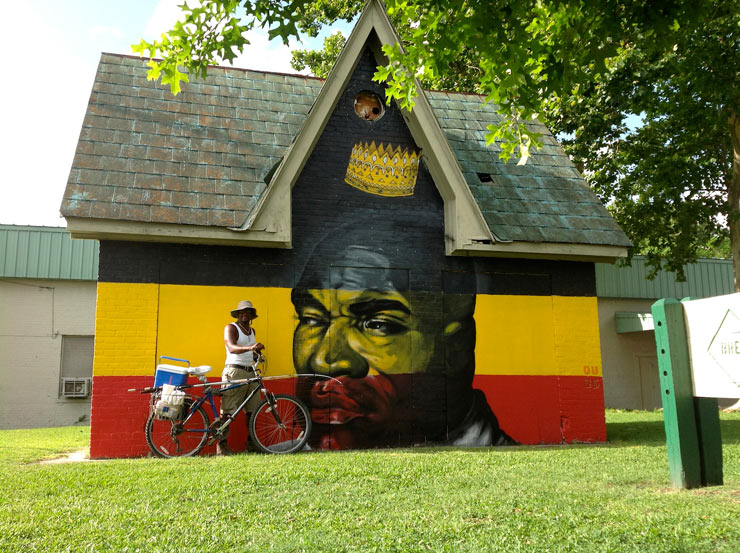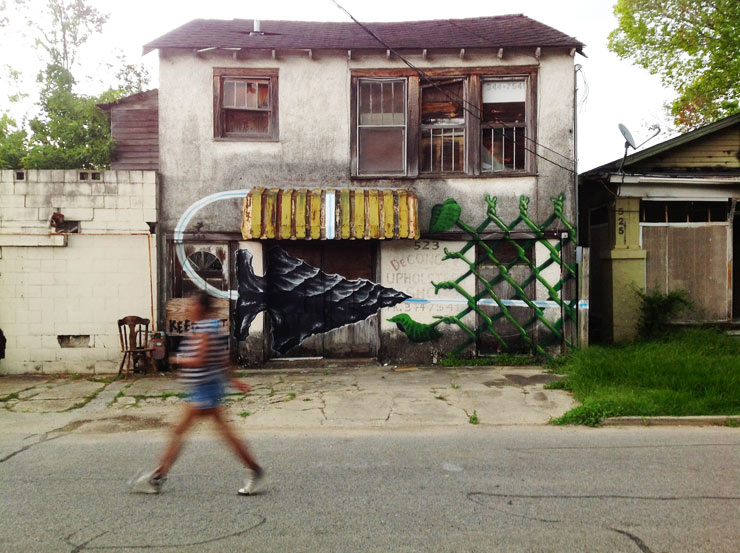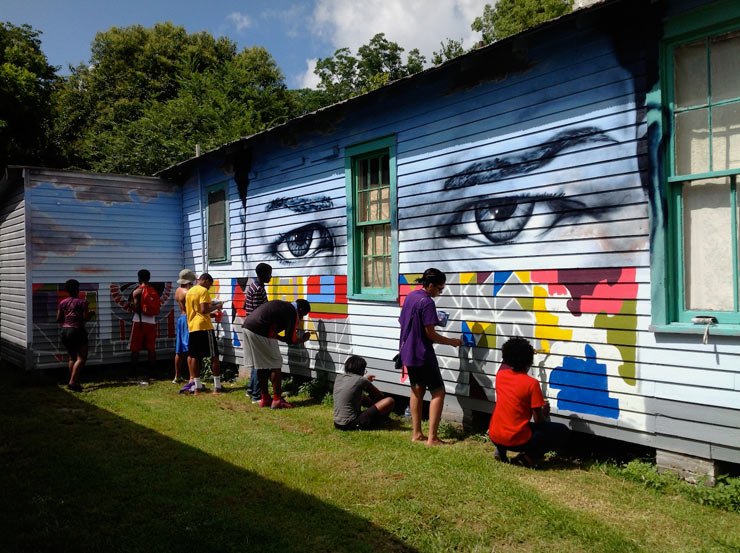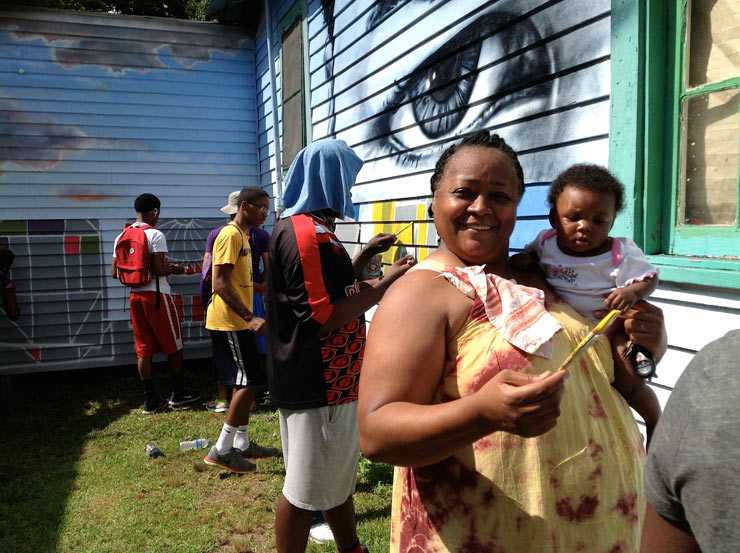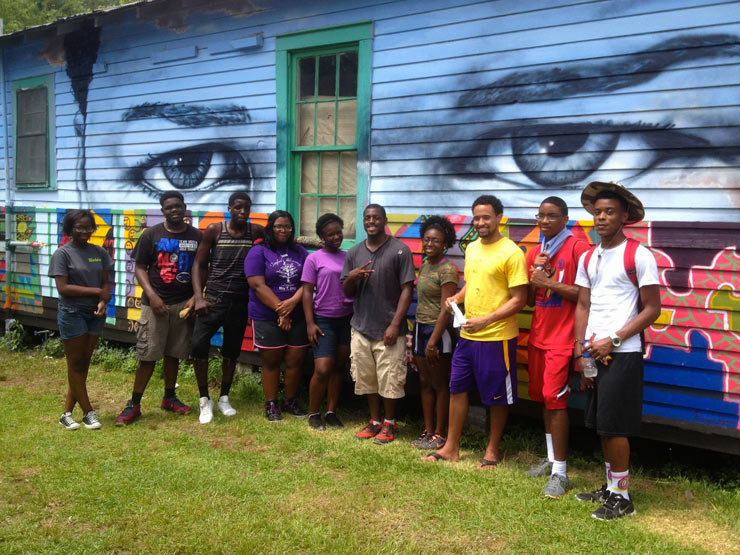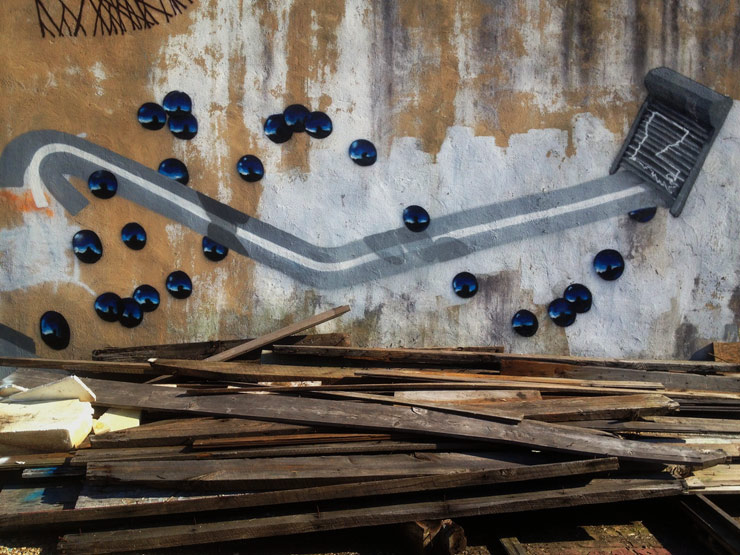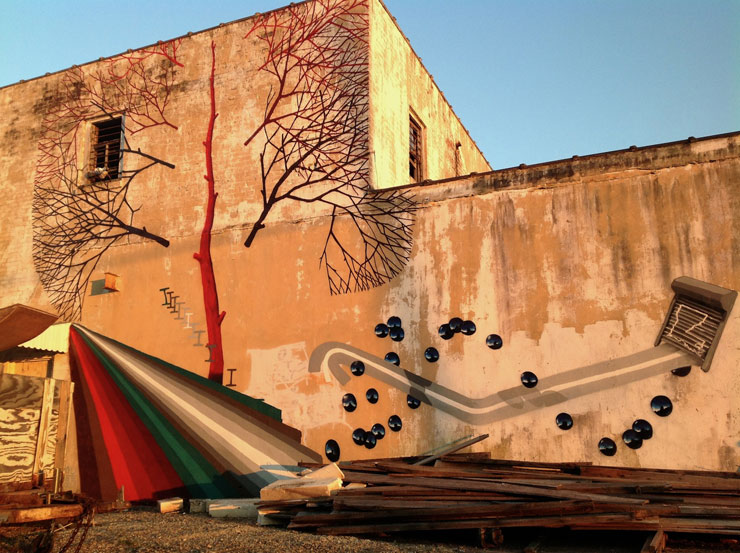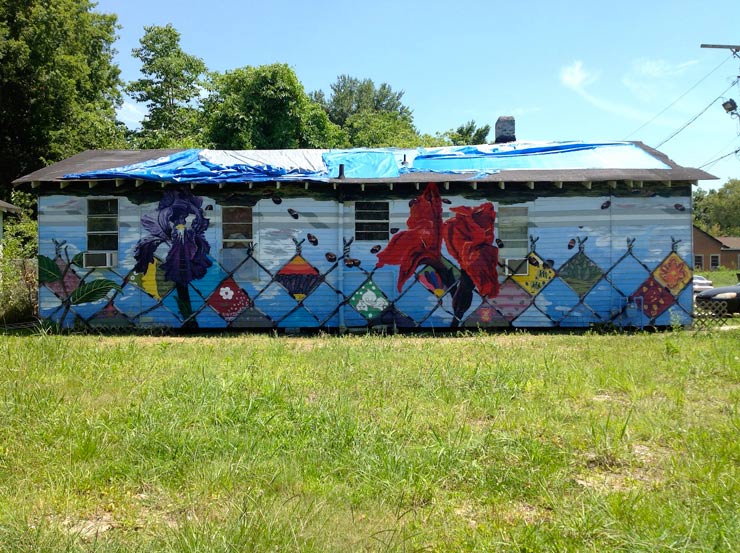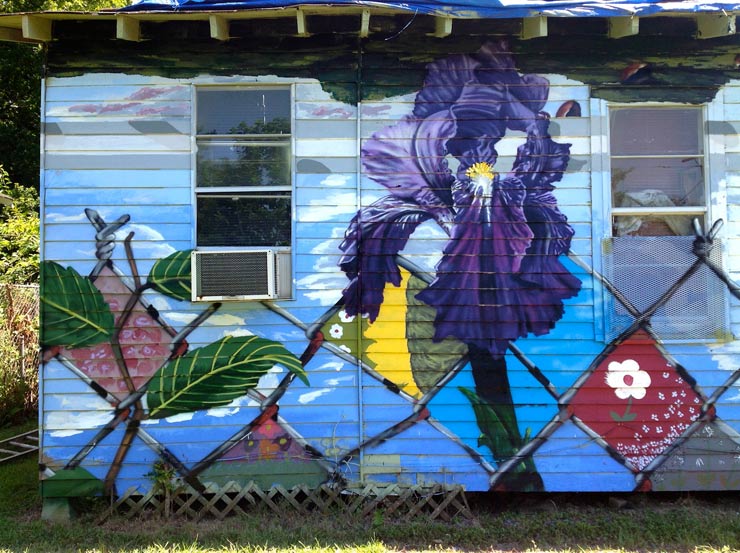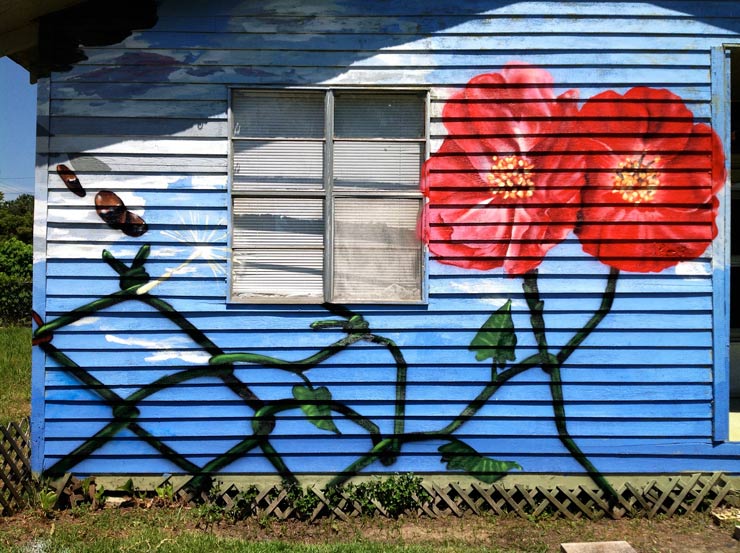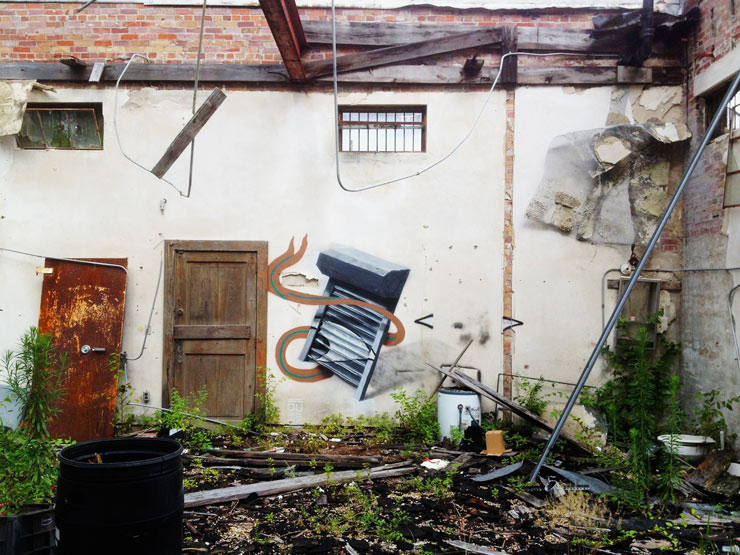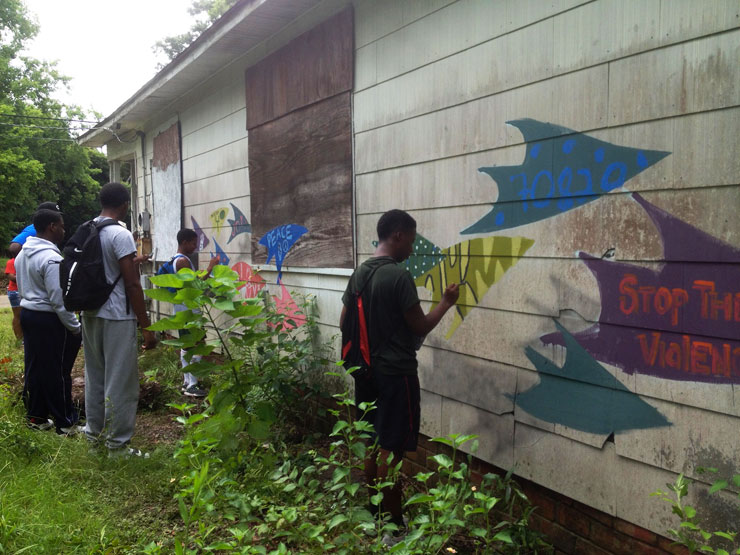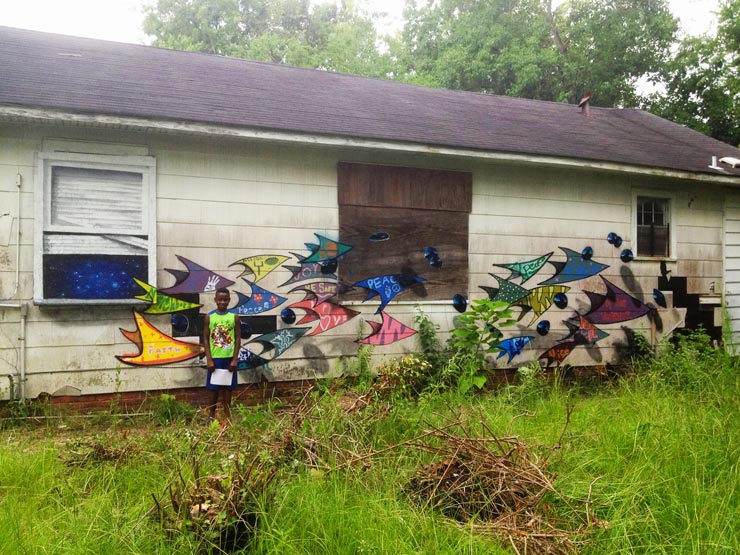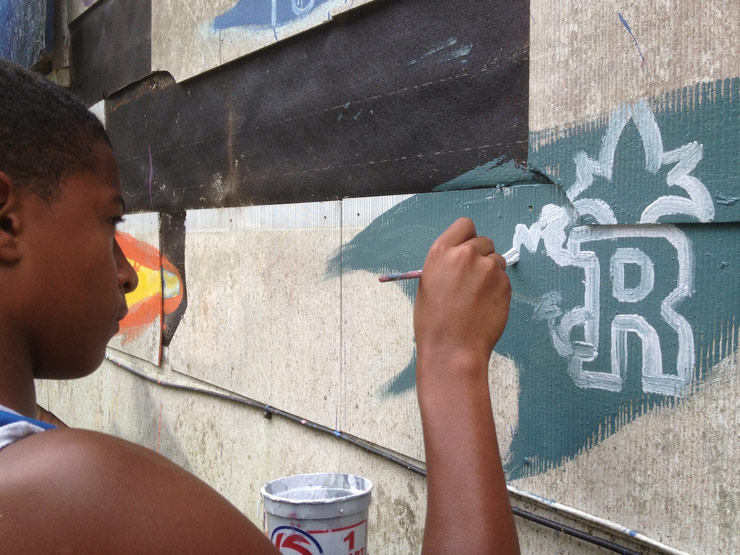“I try to create these open-ended situations with a loose play of abstract iconography to allow various interpretations. My interpretations alone change overtime, which I enjoy, so it makes sense to me to not be too didactic in my public work,” says OverUnder about his work and we can swear by it!
For this piece entitled “The King”, Overunder did a portait based on an anonymous African slave. (photo © Overunder)
The Street Artist and otherwise artist just spent some time in South Baton Rouge, not too far from the Mississippi in Louisiana making a handful of murals with some local youth there. Sponsored by the The Museum of Public Art, OverUnder worked on walls as part of the Love Our Community Summer Youth Employment Program along with some other artists like Seth (Paris), Static (Chicago), Aniekan (Nigeria), Pose2 (CA), Hunto (Italy), and Daze (NY). Overunder reports that the neighborhood where they were creating a majority of work was isolated and abandoned – even though it was just within earshot of downtown and prominent neighborhoods like the Garden District.
Check out this varied collection along with some details of the pieces themselves.
Overunder “Natural Fence” (photo © Overunder)
Overunder “Ben’s House” (photo © Overunder)
This was a class project on the side of one of the students home.”The mural refers to ten of the most historically significant African American quilt templates,” says Overunder of the patterning beneath the huge riveting orbs, as he explains that there were just ten basic building blocks for the multitude of quilt designs that came from the quilt-making tradition in the US.
Overunder. Ben’s Mom painting. (photo © Overunder)
“Of course there are many deviations and permutations but the basic building block of the majority of quilts can be traced back to these ten. While most people (especially the slave masters) viewed these quilts as decorative blankets, the underlying agenda of the quilt patterns and stitching provided an ingenious method of Underground Railroad communication,” he says. “Within these quilts slaves remixed African symbols to convey information pertaining to escaping the bonds of slavery. The quilts in this mural partially obstruct the face as a symbol of protest. The piercing, yet kind expression of the eyes reinforces the notion of communication without words.”
Overunder. Ben’s House reflection. (photo © Overunder)
Overunder. Ben’s House group shot (that’s Benjamin in the center). (photo © Overunder)
Overunder. Sundial. Detail. (photo © Overunder)
For a piece called “Sundial” Overunder made a time capsule for freedom on the 4th of July. “It uses the natural shadows from the building’s architectural features to keep time starting at sunrise, ” he says. “Gradients of color and the letter “I” from the nearby I-beam are transcribed every 15 minutes starting at 7 am. Behind that is a vertical “Red Stick” (Baton Rouge) with radiating detached branches forming the majority of the mural. In the lower right corner is a hovering shutter door graffiti’d with the outline of the state of Louisiana. A highway encompassed my metallic seeds flows out from the shutter door.”
Overunder. Sundial. Detail. (photo © Overunder)
Overunder. Sundial. (photo © Overunder)
Overunder. Iris. (photo © Overunder)
Iris, who owns this house, requested that the collaborative piece include her favorite things, namely, her namesake iris flowers. “She looooved her flowers!” says Overunder, who created a chain link outline for the students to paint their individual floral sections within. He says the Interstate highway and its placement looks like it has a lot to do with the neighborhood’s isolation from affluent neighborhoods and the racial segregation that is evident, and he wanted to reflect that and the history of the neighborhood, if obliquely.
Overunder. Iris. Detail. (photo © Overunder)
“This mural shows an inverted landscape with an abstract interstate dividing the plane. Three large Iris’ grow through the fence, shuffling between the links referencing the history of immigration (both forced and voluntary) as well as the common Louisiana flower and it’s stylized transformation into the iconic fleur de lis. On the front of the house, the fence transforms into 2 criss-crossing wild roses alluding to the concept of fences being a man-made construct based on nature,” says Overunder
Overunder. Iris. Detail. (photo © Overunder)
Overunder (photo © Overunder)
Overunder (photo © Overunder)
Overunder. Old Trap House. (photo © Overunder)
This was a preliminary workshop with Overunder’s students transforming an ex-trap house. “Within each of my signature paper birds the students painted positive messages they wished upon the neighborhood,” he says.
Overunder. Malachi in front of the old trap house. (photo © Overunder)
Overunder. Malachi painting on the old trap house. (photo © Overunder)
Thanks to Dr. Kevin Harris of the The Museum of Public Art.
Other Articles You May Like from BSA:
We’re celebrating the end of one year and the beginning of the next by thanking BSA Readers, Friends, and Family for your support in 2021. We have selected some of our favorite shots from the yea...
The blackened blueish rivers of energy swirling around this former government building in Nantes beguiles your inquisitive mind, wondering what fluid velocity and movement you have been swept into. ...
This week BSA is in Mexico City in collaboration with Urban Nation Museum of Urban Contemporary Art (UN) to see what is steering the scene on the street, meet artists, visit artist compounds, muse...
What are you celebrating this season? We’re celebrating BSA readers and fans with a holiday assorted chocolate box of 15 of the smartest and tastiest people we know. Each day until the new year we...
“Gurl, I Just Came For the Sunburn” is the cleverly worded T-shirt design we just conjured, but didn’t see in any of the many stores selling “Miami”-emblazoned memorabilia this weekend. New Yorke...
 BROOKLYN STREET ART LOVES YOU MORE EVERY DAY
BROOKLYN STREET ART LOVES YOU MORE EVERY DAY